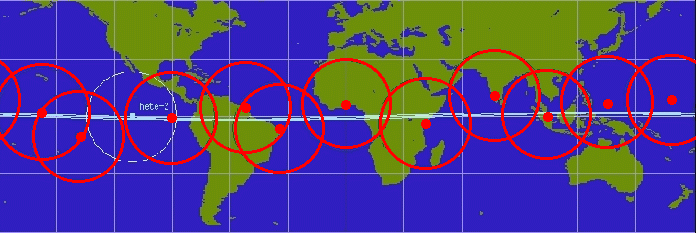
 | Home | Status | Goals | Team | History | Spacecraft | Instruments | Ground | Alerts | FAQ | Gallery |
| Primary | Secondary | ||||||||||
HETE-2's low orbit allows the broadcasts from a low power transmitter to be picked up by a simple ground antenna and receiver. These secondary ground stations must be located within the footprint of the satellite's path, or within 15 degrees latitude of the equator.
Messages are transmitted to the MIT Control Center and arrive less than 5 seconds after a burst alert has been issued. Summaries of burst alerts are forwarded, as appropriate, to the GRB Coordinates Distribution Network as soon as they are received from the spacecraft. thereby allowing early follow-on observations.

|
An inexpensive ground stationThe Secondary Ground Station was designed to be relatively inexpensive, and consists of:
|

| Site | Longitude | Latitude | Pass length* |
|---|---|---|---|
| Kwajalein | 167.717 E | 8.717 N | 13.10 m |
| Christmas Island | 157.1 W | 1.9 N | 13.93 m |
| Nuku Hiva (French Polynesia) | 140.00 W | 9.5 S | 12.93 m |
| Galapagos Island (Ecuador) | 91.1 W | 0.72 S | 13.98 m |
| Cayenne (French Guiana) | 51.9 W | 4.9 N | 13.71 m |
| Natal (Brazil) | 35.13 W | 5.47 S | 13.64 m |
| Accra (Ghana) | 0.17 W | 5.6 N | 13.63 m |
| Malindi (Kenya) | 40.19 E | 3.00 S | 13.86 m |
| Ootacamund (India) | 76.66 E | 11.38 N | 12.45 m |
| Singapore | 103.83 E | 1.33 N | 13.96 m |
| Koror (Palau) | 134.5 E | 7.33 N | 13.36 m |